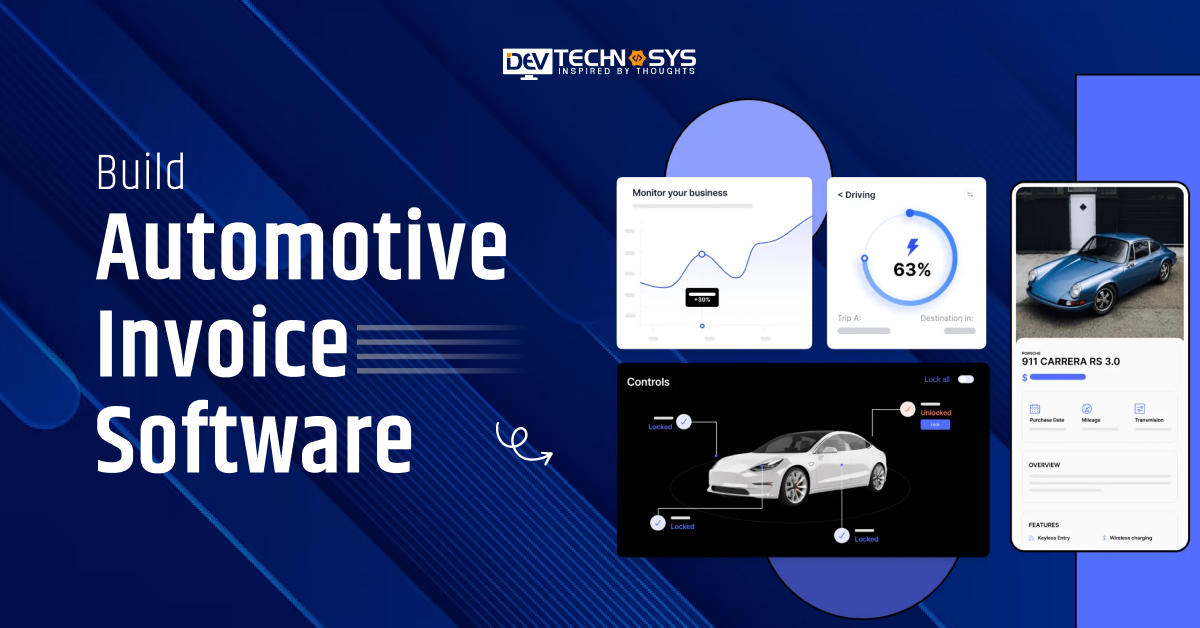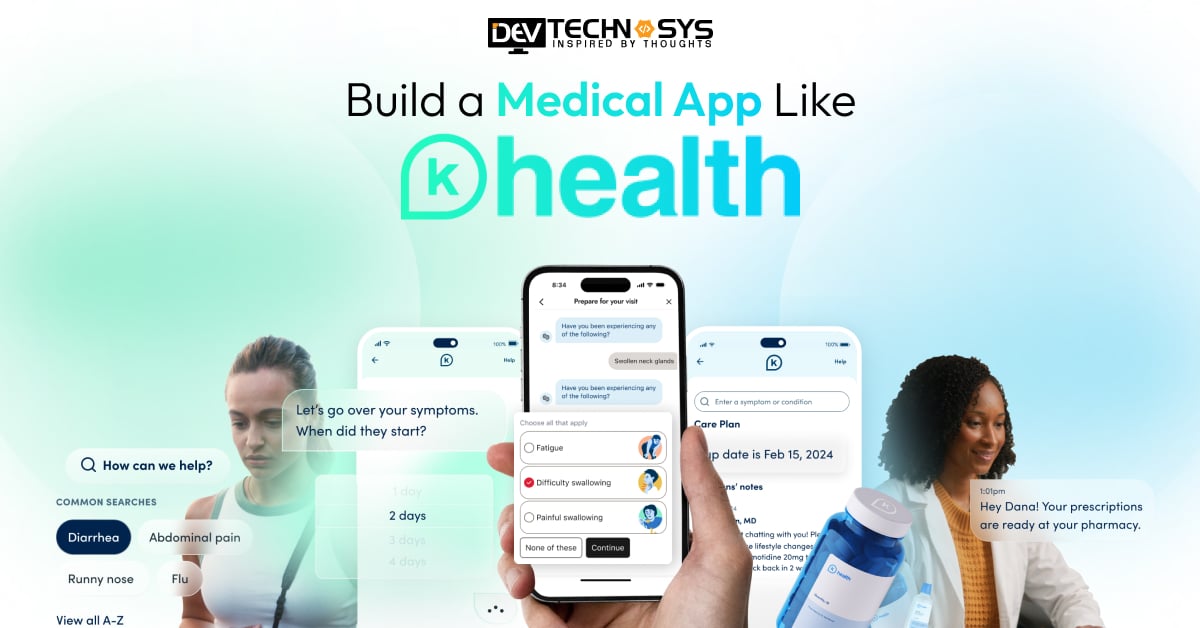In the motor vehicle industry, managing financial records is one of the most complex tasks, as well as generating invoices for sales and service of vehicle parts. To reduce manual or human errors, there is an automotive invoice software that allows car dealers or repair shops to manage and generate invoices for overall sales and related vehicle services.
As per the ground-level report, the automotive invoice software was valued at around $12.64 billion in 2024. It is projected to grow around at a compound annual growth rate of 8.7% during the forecast period of 2025 to 2030.
The above data depicts that investing in automotive invoice software is the most lucrative opportunity for entrepreneurs to grow their businesses.
In this blog, we will explore how to build automotive invoice software, development costs, benefits, advanced functionalities, and monetization techniques.
Let’s begin!
What is Automotive Invoice Software?
Automotive invoice software is a technology that helps organizations in the automotive sector create, organize, and process invoices for car sales, maintenance, and components. It makes it easier to track inventory, provide discounts, and manage payments. The software frequently connects with accounting systems and assists firms in maintaining accurate financial records, increasing productivity and decreasing errors while providing features suited to the demands of automobile dealers and service providers.
- Invoice Customization
- Payment Tracking
- Customer Management
- Inventory Integration
Market Analysis of Automotive Invoice Software
- In 2024, the automotive invoice software was estimated to be worth $12.64 billion. During the 2025–2030 forecast period, it is expected to increase at a compound annual growth rate of 8.7%.
- Over the course of the forecast period, North America is anticipated to maintain the biggest market share in the billing and invoicing software market.
- Accounts receivable, accounts payable, customer relationship management (CRM), enterprise resource planning (ERP), and project management are just a few of the industries and applications that employ billing and invoicing software.
- The following are major rivals in the market for billing and invoicing software: Xero, Zoho, FreshBooks, QuickBooks, SAP, Oracle, NetSuite, Intacct, Sage, and Bill.com.
- Growing acceptance of cloud-based solutions, the need for effective invoicing and billing procedures, and the number of small and medium-sized businesses are driving the Billing and Invoicing Software Market.
Top 10 Automotive Invoice Software
These software products provide a number of specialized features designed to improve the invoicing, inventory, and customer management operations in automobile enterprises. Here’s a table listing the top 10 automotive invoice software.
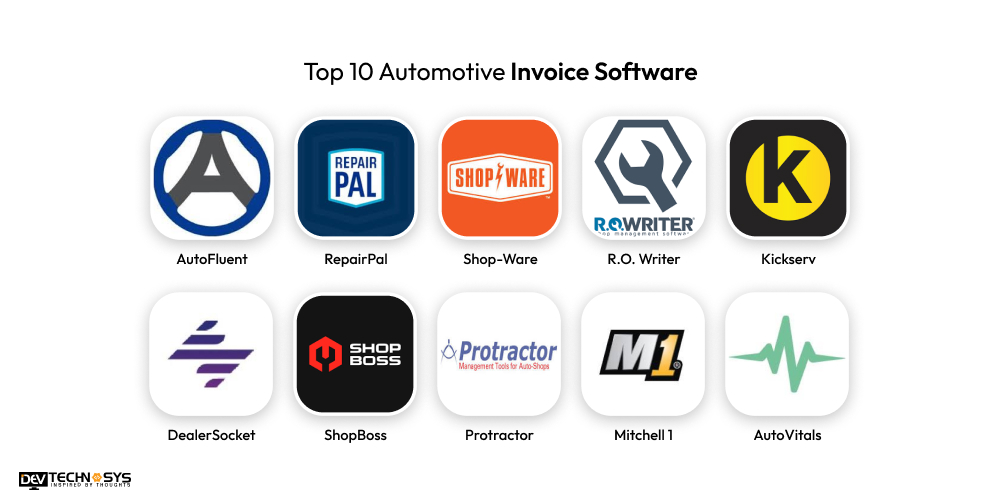
| Software | Special Features | Launched Year |
| AutoFluent | – Inventory and parts management
– Customer relationship management – Integrated accounting and reporting |
2003 |
| RepairPal | – Pricing calculator for parts and labor
– Service history tracking – Warranty tracking |
2007 |
| Shop-Ware | – Real-time service tracking
– Digital vehicle inspection – Mobile access for technicians |
2012 |
| R.O. Writer | – Quick-service invoicing
– Seamless integration with CRM – Real-time labor tracking |
1995 |
| Kickserv | – Job scheduling and invoicing
– Payment tracking – Customer management and communication tools |
2012 |
| DealerSocket | – Full CRM integration
– Vehicle trade-in analysis – Automated customer follow-up |
2001 |
| ShopBoss | – Customizable invoicing templates
– Multi-shop management – Automated reminders and alerts |
2016 |
| Protractor | – Detailed customer and service records
– Inventory and parts tracking – Cloud-based access |
1990 |
| Mitchell 1 | – Service repair database integration
– Customizable invoicing – Comprehensive parts catalog |
1918 |
| AutoVitals | – Digital vehicle inspections
– Customer communication tools – Performance reports and analytics |
2009
|
Why Do Entrepreneurs Choose to Invest in Automotive Invoice Software Development?
By investing in automotive invoice software, entrepreneurs can enhance operational efficiency, improve accuracy, and support business growth, all while providing a better experience for their customers. Entrepreneurs choose to invest in the software product development of automotive invoices for several compelling reasons:
- Streamlined Operations
- Increased Accuracy and Decreased Errors
- Better Financial Management
- Improved Customer Experience
- Scalability and Growth
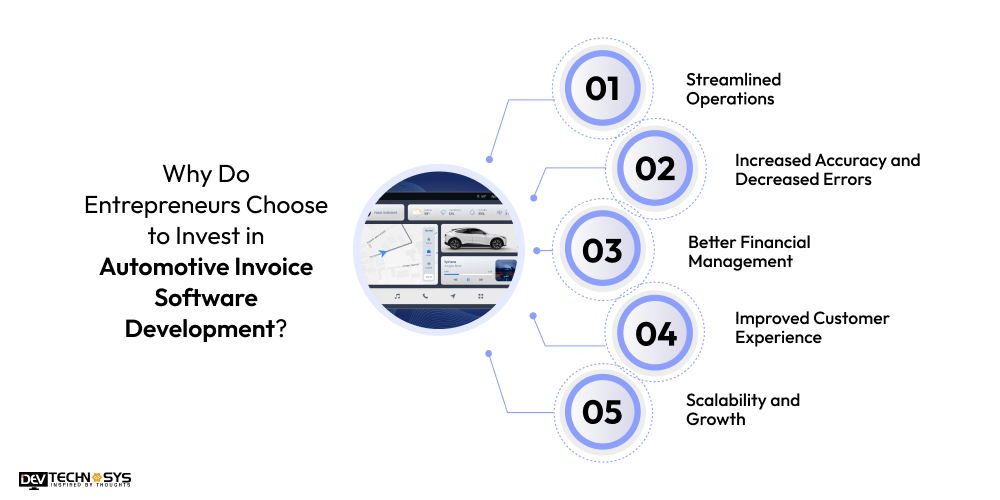
1. Streamlined Operations
Automotive invoice software streamlines the invoicing process, making it easier for businesses to create, manage, and track invoices. This automation saves time and effort on manual chores, allowing entrepreneurs to focus on other important elements of their firm, such as customer service or expansion strategy.
2. Increased Accuracy and Decreased Errors
Manual invoicing can result in inaccuracies, affecting cash flow and customer satisfaction. Automotive invoicing software enables accurate computations, reduces human error, and complies with tax requirements. This decreases the likelihood of costly errors, such as wrong pricing or missing data.
3. Better Financial Management
Automotive invoice software integrates with accounting systems, giving entrepreneurs real-time insights into their company’s financial health. This aids in the tracking of sales, payments, taxes, and outstanding balances, providing entrepreneurs with a more complete picture of cash flow and enabling them to make informed decisions.
4. Improved Customer Experience
Many automobile invoicing software solutions provide customer management capabilities, which enable firms to store customer information, track service history, and create tailored invoices. As we discussed earlier with SaaS application development company, this level of structure and attention to detail can enhance the customer experience, resulting in increased client retention and loyalty.
5. Scalability and Growth
As automotive firms grow, manually maintaining invoices becomes increasingly burdensome. Investing in software that is scalable with the firm guarantees that invoicing is efficient and accurate as the company grows. It also allows business owners to add new locations or services without overwhelming existing accounting and invoicing systems.
7 Knowledge Steps to Build Automotive Invoice Software
To build an auto repair shop management software, follow the crucial steps that help businesses or developers to integrate each phase easily and develop successful software. So, here we provide the software development process:
- Define Requirements and Needs
- Features and Functions
- Right Tech Stacks
- Design UI/UX
- Software Development
- Testing and QA
- Launching and Maintenance
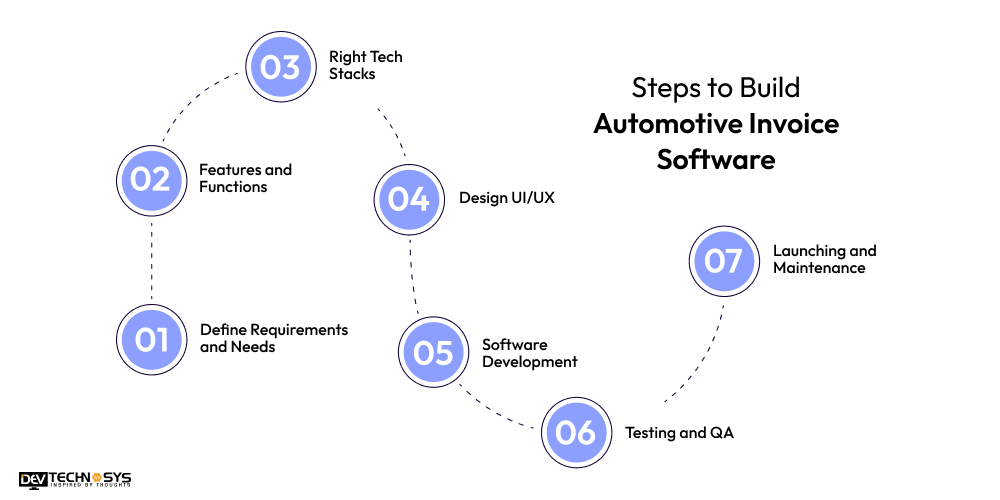
1. Define Requirements and Needs
Begin by understanding the core requirements of the automotive invoice software. Analyze user needs, including invoice generation, payment tracking, and reporting. Collaborate with stakeholders to ensure the software addresses all necessary features for the target audience.
| What are your project’s basic or core requirements? |
| Define your future goals. |
| Which automotive invoice software is more trending in this competitive market? |
2. Features and Functions
Identify essential features such as customizable templates, tax calculations, payment integration, inventory management, and reporting tools. Hire software developers to determine any additional functions like user roles, multi-currency support, and data export capabilities to ensure the software meets user expectations.
| What are your project’s basic features and functions? |
| Analyze the popular automotive invoice software. |
| Make an organized sheet of features and functions to reduce confusion. |
3. Right Tech Stacks
Choose the right tech stack, including frontend, backend, and database technologies. Common choices include React or Angular for frontend, Node.js or Django for backend, and MySQL or MongoDB for database management. Ensure scalability, security, and performance are prioritized in the stack.
| Which type of tech stacks are used in your car repair shop invoicing software development? |
| Define your scalability requirements. |
| Choose advanced or core tech stacks. |
4. Design UI/UX
Let’s move to the fourth custom software development step, design an intuitive and user-friendly interface that simplifies invoicing tasks. Focus on clarity, easy navigation, and visual appeal to enhance user experience. Ensure mobile responsiveness and incorporate features such as drag-and-drop invoice creation to improve accessibility and efficiency.
| What are wireframes in UX design? |
| What tools do you use for prototyping? |
| How do you ensure a responsive design? |
5. Software Development
Develop the software in iterations, focusing on building core functionalities first. Follow best coding practices and agile methodologies to ensure flexibility and adaptability. Implement secure user authentication, seamless invoice creation, and integration with third-party services like payment processors.
| How to process backend services? |
| Choose the experienced developers. |
| Implement a high number of features and functions. |
6. Testing and QA
Conduct software testing services, including unit, integration, and user acceptance tests. Ensure the software functions as expected under various scenarios. Focus on identifying bugs, validating security measures, and ensuring compatibility with different devices and browsers for optimal performance.
| Make sure that all features and functions are working properly |
| Use various testing methods, such as unit and security testing |
| Implement robust security methods |
7. Launching and Maintenance
Launch the software with clear documentation and user support. Monitor its performance, resolve issues promptly, and release updates based on user feedback. Regularly maintain the system, applying patches and improvements to ensure continued functionality and address evolving user needs.
| Launch your software on the live phase. |
| Use the best marketing techniques to promote the software. |
| Assign the post-maintenance phases to maintain the software performance. |
10 Premium Features of Automotive Invoice Software
Automotive invoice software comes with a range of premium features designed to streamline billing and improve business operations. Here are 10 key automotive invoice software features:
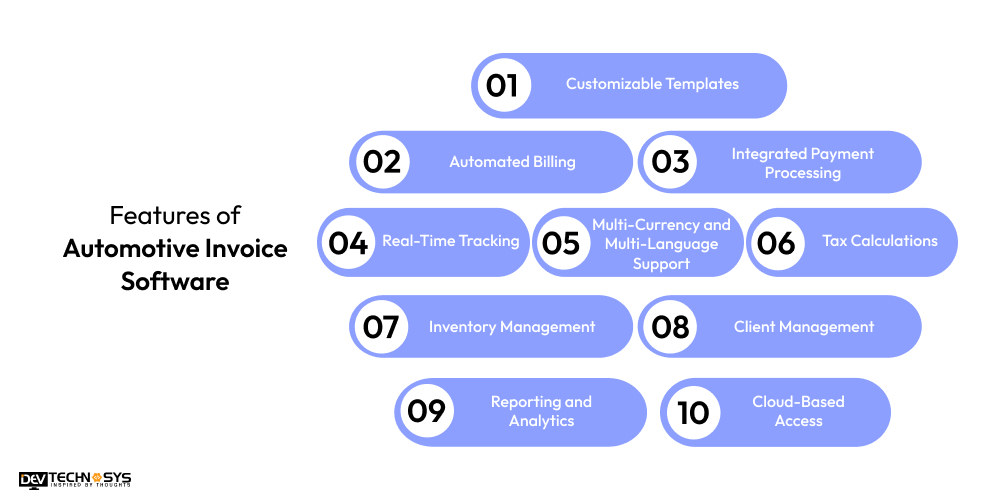
-
Customizable Templates
Auto repair invoicing software offers tailor invoices with your logo, branding, and specific fields relevant to the automotive industry, such as vehicle details and service types.
-
Automated Billing
Automatically generate invoices based on recurring services or repair jobs, reducing manual input and errors.
-
Integrated Payment Processing
A car repair billing software accepts payments directly through the software via credit cards, bank transfers, or integrated payment gateways.
-
Real-Time Tracking
Monitor payment statuses, service progress, and parts inventory in real time, ensuring full visibility of financial transactions.
-
Multi-Currency and Multi-Language Support
The vehicle invoice management system provides multi-currency and multi-language support to enable invoicing in various currencies and languages, catering to international clients and expanding reach.
-
Tax Calculations
If you develop an automotive website, it automatically calculates and applies the correct tax rates based on location, ensuring compliance with local regulations.
-
Inventory Management
Track spare parts, labor hours, and vehicle details alongside invoicing to streamline the entire repair or service process.
-
Client Management
Store and manage customer profiles, service history, and payment data to enhance customer relationship management.
-
Reporting and Analytics
The automotive invoicing system generates detailed reports on sales, revenue, and outstanding invoices, helping businesses make data-driven decisions.
-
Cloud-Based Access
Custom auto repair invoicing system offers secure, cloud-based storage that allows access to invoices, client data, and reports from anywhere, ensuring convenience and security.
What is the Cost to Build Automotive Invoice Software?
The cost to build automotive invoice software depends on factors like complexity, features, and development platform. A basic version may cost between $8,000 to $15,000, while more advanced, feature-rich software with customizations, multi-currency support, cloud integration, and real-time tracking could range from $18,000 to $25,000.
Ongoing maintenance, updates, and hosting may add additional costs, typically 15-20% of the initial automotive software development cost annually. If using third-party platforms or tools for development, licensing fees may also impact pricing. Custom development by a skilled team or a reputable agency generally ensures quality and long-term scalability.
Cost to Create Automotive Invoice Software
| Automotive Invoice Software Development | Estimated Cost | Time Frame |
| Basic Software Development | $8000 – $13000 | 2 to 5 Months |
| Mid-Premium Software Development | $12000 – $20000 | 6 to 8 Months |
| High-Premium Software Development | $25000+ | 9+ Months |
5 Key Factors That Affect Automotive Invoice Software Development Cost
A variety of factors influence the cost of producing automobile invoice software. Here are the five most important:
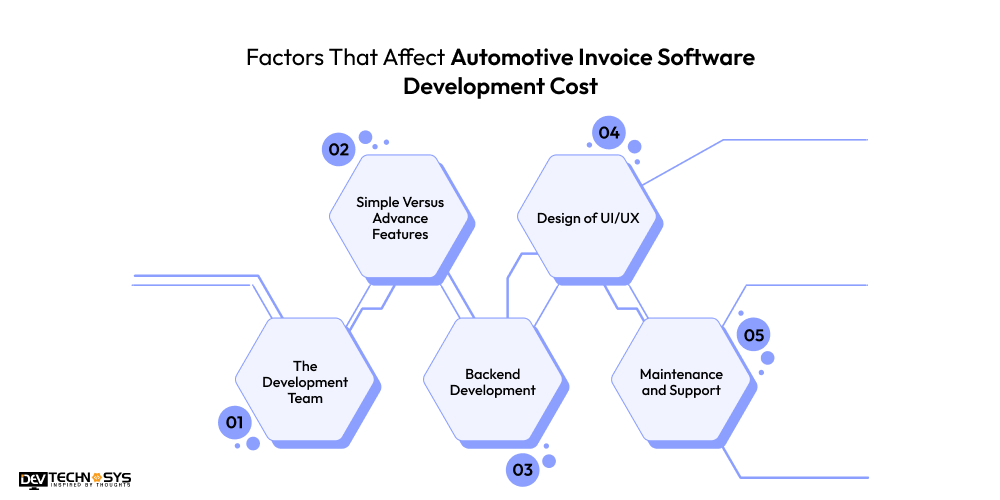
1. The Development Team
The number and experience of the software development team also affect the cost. Hiring qualified specialists such as project managers, developers, designers, and quality assurance experts increases the overall cost. Developers with specific knowledge in the automotive industry or financial systems may charge greater fees.
| Developer’s Location | Cost Estimation |
| Asia Pacific | $8,000 – $15,000 |
| North America | $15,000 – $20,000 |
| Eastern Europe | $13,000 – $18,000 |
| Western Europe | $16,000 – $25,000 |
2. Simple Versus Advance Features
The software’s feature set has a substantial impact on its development costs. Basic services such as invoice generating, tax calculation, and payment tracking are less expensive. Premium features, such as multi-currency support, automatic invoicing, inventory management, real-time tracking, and advanced reporting, considerably increase development complexity and costs. Custom interfaces with payment gateways, CRM systems, and parts management solutions also increase the cost.
| Features | Cost Estimation |
| Core Features(Payment Tracking and Client Management) | $8,000 – $13,000 |
| Advanced Features(Multi-Currency Support and Automated Recurring Invoices) | $15,000 – $19,000 |
3. Backend Development
The backend architecture is where much of the complexity lies. This covers database management, server-side logic, payment processing, and system integration. A strong backend assures security, scalability, and performance, yet developing such infrastructure necessitates the use of professional developers and can drastically increase costs.
| Backend Development | Cost Estimation |
| Basic Backend Process | $10,000 – $18,000 |
| Premium Backend Process | $20,000 – $28,000 |
4. Design of UI/UX
A well-designed user interface (UI) and a smooth user experience (UX) are critical for ease of use and client pleasure. High-quality UI/UX design takes time and talent, especially when it involves unique dashboards, intuitive layouts, and mobile adaptability. The software development cost increases as the design becomes more complicated and personalized.
| Design Quality | Cost Estimation |
| Basic Design | $8,000 – $12,000 |
| Complex Design | $15,000 – $22,000 |
5. Maintenance and Support
After the software is established, it requires continuing maintenance and support to maintain it up to date, secure, and functional. Regular updates, bug repairs, and technical support all require resources and are normally billed on an annual basis, at 15-20% of the initial development cost.
| Maintenance Phase | Cost Estimation |
| Simple Maintenance Phase | $2,000 – $4,000/year |
| Complex Maintenance Phase | $8,000 – $10,000/year |
5 Money-Making Techniques of Automotive Invoice Software
By utilizing these techniques, automotive invoice software developers can establish a sustainable revenue stream while providing businesses with valuable, efficient tools. Automotive invoice software can generate revenue through various money-making techniques. Here are five key strategies:
- Subscription-Based Model
- Custom Development and Add-Ons
- Transaction Fees
- Freemium Model
- Affiliate Partnerships
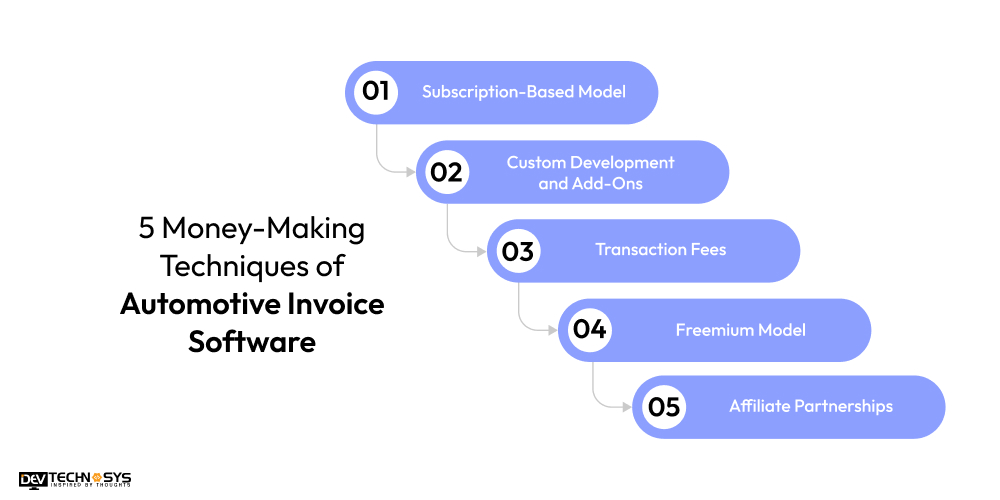
1. Subscription-Based Model
One of the most common revenue models for software is the subscription-based approach. Users pay a recurring fee (monthly or annually) to access the software. This creates a steady stream of revenue and ensures customer retention. You can offer different pricing tiers based on the size of the business or features needed, such as a basic package for smaller businesses and premium options with advanced functionalities.
2. Custom Development and Add-Ons
Offering customization services for businesses that require specific features can be a lucrative revenue stream. Many automotive businesses may need tailored solutions, such as integrating with existing inventory management or CRM systems. Charging additional fees for custom development or offering exclusive add-ons (like advanced reporting tools) can significantly boost your income.
3. Transaction Fees
If the software integrates payment gateways, you can charge a small transaction fee for every payment processed through the system. According to the software development company, this is especially profitable if the software handles a high volume of transactions, making the fee per transaction a consistent source of income.
4. Freemium Model
Providing a free version of the software with limited features encourages businesses to try the product. The goal is to get users hooked on the basic functions and then offer premium features (such as advanced invoicing, multi-language support, or API integrations) as part of a paid upgrade. This model can attract a large user base and generate significant revenue once users see the value in upgrading.
5. Affiliate Partnerships
Partnering with third-party vendors (such as accounting software or payment gateways) and earning commissions on sales through affiliate marketing is another way to monetize automotive invoice software. If your software integrates with these third-party tools, offering recommendations can lead to passive income through affiliate links or referral fees.
Conclusion
It’s time to say goodbye. We explored how to build automotive invoice software and various functionalities that help businesses determine what type of features should be integrated. With the help of automotive invoice software, businesses can generate invoices in multiple languages and store the basic information of customers, such as name, address, and vehicle details. After that, we provide the development cost that helps businesses to get an estimated idea of cost, and we also offer the monetization techniques that provide new revenue streams.
If you want to develop automotive invoice software, you can freely connect with an automotive software development company to provide budget-friendly software.
Frequently Asked Questions
1. How Much Does It Cost To Build Automotive Invoice Software?
The cost to develop automotive invoice software ranges from $8,000 to $25,000, based on features, design complexity, and development team competence. Customizations, integrations, and continuous maintenance might increase the overall cost.
2. How Much Time Does It Take To Make Automotive Invoice Software?
To create automotive invoice software typically takes 3 to 9 months, depending on complexity, features, and customizations. Factors like design, integrations, and testing can influence the timeline, with more advanced features extending the development period.
3. Can Automotive Invoice Software Integrate with Other Systems?
Yes, current automobile invoicing software is compatible with accounting systems, customer relationship management (CRM) tools, and payment gateways. By synchronizing data across many systems, integration streamlines procedures and improves efficiency.
4. What Features Should Automotive Invoice Software Have?
Invoice production, payment monitoring, client administration, tax computations, and customizable templates are all essential elements. Advanced features may include multi-currency compatibility, automatic billing, inventory management, and reporting/analytics.
